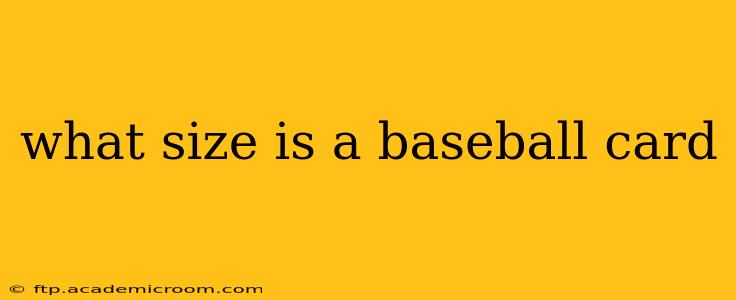What Size is a Baseball Card? The Definitive Guide to Dimensions and Variations
Baseball cards: small pieces of cardboard that hold a world of memories, statistics, and sometimes, incredible value. But just how big are they? While the standard size is fairly consistent, there are some variations you should be aware of. This guide will cover everything you need to know about baseball card dimensions, including common sizes and historical changes.
What are the standard dimensions of a baseball card?
The standard size of a modern baseball card is 2.5 inches wide by 3.5 inches tall. This is the size you'll find the vast majority of cards produced today by Topps, Panini, Upper Deck, and other major manufacturers. Think of it as a slightly smaller than a standard index card.
Are there any variations in baseball card sizes?
While the 2.5" x 3.5" size is the dominant standard, some variations exist:
-
Vintage Cards: Older cards, particularly those from the early to mid-20th century, can have slightly different dimensions. These variations are often subtle, but collectors meticulously note these differences. Size can be a key factor in authentication and grading.
-
Mini Cards: Many sets include "mini cards," often smaller versions of the standard-sized cards, included as inserts or part of a promotional offering. These can range significantly in size.
-
Oversized Cards: Some premium or high-end sets will feature oversized cards as a way to showcase special artwork or highlight particular players. These cards are considerably larger than the standard size.
-
Custom-sized Cards: While rare in mass-produced sets, custom-made or one-of-a-kind cards could have almost any dimensions.
What about the thickness of a baseball card?
The thickness of a baseball card isn't as strictly standardized as its length and width. However, most cards fall within a range of approximately 0.03 inches (or 0.76mm). The card stock used influences this slightly – thicker card stock is often used for higher-end cards.
Why do baseball card sizes matter?
Understanding baseball card sizes is crucial for several reasons:
-
Collecting and Grading: Knowing the standard size helps collectors identify potential counterfeits or altered cards. Grading companies like PSA and Beckett use precise measurements as part of their authentication and grading process.
-
Storage and Protection: Proper storage requires consideration of card size. Using the correct-sized sleeves, toploaders, and storage boxes ensures the cards remain protected from damage and degradation.
-
Display and Framing: If you plan on displaying your cards, knowing their dimensions helps you determine appropriate frames and display cases.
How have baseball card sizes changed throughout history?
Baseball card dimensions haven't changed drastically over time, but subtle variations existed, particularly in the early years. Early cards often showed slight inconsistencies in their cutting and printing processes, leading to size variations. The standardization to the near-universal 2.5" x 3.5" size is a relatively recent phenomenon, solidifying around the mid-20th century.
This comprehensive guide provides a clear picture of the typical dimensions of a baseball card and addresses potential variations. Knowing these dimensions enhances your collecting experience, assisting in card identification, protection, and display. Remember that while the standard size provides a valuable benchmark, the details can vary. Happy collecting!
